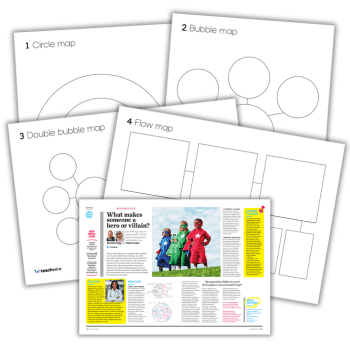You Keep Using that Word – Why Ofsted’s use of ‘consistency’ doesn’t mean what you think it means

If you’re trying to impress with wall displays that are designed with a set square, you’re missing the point, says Julie Price Grimshaw… A headteacher told me recently that her biggest concern was the “lack of consistency” across the school. Having visited classrooms and been impressed with what I’d seen, I asked what she meant. […]

- by Julie Price Grimshaw
- Teacher, trainer and education adviser Visit website

If you’re trying to impress with wall displays that are designed with a set square, you’re missing the point, says Julie Price Grimshaw…
A headteacher told me recently that her biggest concern was the “lack of consistency” across the school. Having visited classrooms and been impressed with what I’d seen, I asked what she meant. “Sometimes teachers like to do their own thing. What concerns me most is that they don’t always mark in quite the same way. Ofsted isn’t going to like that.” The teachers were certainly doing something right. Achievement was at an all-time high and pupils were happy and motivated learners – from an inspector’s point of view, what’s not to like? However, it got me thinking about consistency and just how important it is.
Knuckle-chewing boredom
The head of a school I visited last year was proud of the consistency in approach across all classes. “You’ll see exactly the same thing in every class in my school”, she said. And she wasn’t wrong. Every single lesson started with what appeared to be a rather tedious task – copying something from the board, for example, which seemed to have nothing to do with the learning in the lesson. “Every lesson must start with a settling activity in silence,” I was told. I was struggling to see the benefits; most pupils looked like they needed a ‘waking-up activity’ rather than a ‘settling activity’. Some, not surprisingly, lost concentration and started to fidget. After 10 minutes I almost started to chew my own knuckles with boredom. I was woken by the headteacher saying “Did you see those boys fidgeting? That’s exactly why we need a settling activity in every class, every lesson, every day.”
It got worse. “Every display board must be lined with yellow backing paper and have a four-inch blue border. All display text must be in Chalkboard font. Every classroom has a special board for the WALT and WILF”. The question that Ofsted would ask about this school’s rather extreme approach to consistency is, quite simply, what’s the impact on learning? Interestingly, in this particular school there was a great deal of inconsistency in the quality of learning across different classes.
Consistency of quality
The word ‘consistently’ comes up in the Ofsted inspection handbook many times, but Ofsted is clearly not referring to the rather ‘OCD’ approach in the school mentioned above.
The descriptor for outstanding teaching states that, ‘Much teaching over time in all key stages and most subjects is outstanding and never less than consistently good’ – resulting in pupils making ‘sustained progress that leads to outstanding achievement’. As always, it’s the impact that’s important here, but it’s vital to note that ‘consistently’ is referring to quality. Getting everyone to do exactly the same things in the same way may be a ‘consistent approach’, but it certainly does not guarantee consistently high quality. Consistency – or the lack of it – in marking and feedback does seem to be causing a good deal of grief in some schools at the moment. The school policy usually outlines a particular approach – for instance, the use of green and purple pens or ‘What went well/even better if’. There’s nothing wrong with any of these approaches if they work well in your school, but some schools have fallen into the trap of thinking that Ofsted is more interested in blanket compliance rather than impact. The descriptor for ‘outstanding’ teaching states that ‘Consistently high-quality marking and constructive feedback from teachers ensure that pupils make significant and sustained gains in their learning’. Again, the word ‘consistently’ refers to quality. In its March 2015 School Inspection Update [PDF], Ofsted stated that marking and feedback should be consistent with the school’s policy, ‘which may cater for different subjects and different age groups of pupils in different ways, in order to promote learning effectively’.
In other words, everyone should stick to the school’s policy but it’s fine to have differences within the policy. My mantra is always ‘If it works well, do it. If it doesn’t, bin it or change it’. Consistency in quality is what we should be striving for. Routines can be very important and there have to be minimum expectations of us all as teachers. Beyond that, vive la différence!
Julie Price Grimshaw is a teacher, teacher trainer, and education consultant. Her book, Self-propelled learning and effective teaching, is available via Amazon










